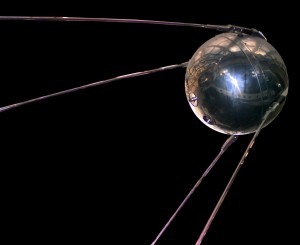Sputnik
On October 4, 1957, a 25-in diameter metal ball was launched from Kazakhstan. Once in space, it orbited around the Earth three months while sending radio signals for 22 days for all to hear. It was the Sputnik I, the first artificial satellite in history and it was the first successful attempt of space exploration for mankind.
For several people, Sputnik means several things. In the literal sense, Sputnik in the English Language means “fellow traveler” which makes sense for a satellite. For the former Soviet Nations, Sputnik was the pinnacle of its technology and a not-so-subtle message for the US in the middle of the Cold War. For my father, as for millions of people around the world, it was the breaking of paradigms using a sledgehammer. The idea of a man-made object traveling the infinite and unreachable space was almost a heresy or just as possible as a Verne’s tale. For the US population, Sputnik’s flight was received with a mixture of wide sp read concern and sincere admiration as most of the newspapers from October 5 show. For the US government it was a warning call to get things going. Rushing things up, the US completed self-humiliation after the disastrous launch -if you can call that to rising some feet above the ground- of the US Navy’s Vanguard rocket, just two months after Sputnik.
read concern and sincere admiration as most of the newspapers from October 5 show. For the US government it was a warning call to get things going. Rushing things up, the US completed self-humiliation after the disastrous launch -if you can call that to rising some feet above the ground- of the US Navy’s Vanguard rocket, just two months after Sputnik.
Among other things, Cold War was a frantic race towards the hegemony of the skies between the US and the Soviet Union. On one hand, the US had Werner Von Braun in charge of another rocket program. Von Braun was a former Nazi mastermind behind the V-2 rockets that poured over London in the WWII. Later, Von Braun’s group would reach complete success with the design of Saturn 5 for the Apollo missions that put men on the moon. On the other hand, Sergei Korolyov, a former gulag prisoner, was in charge of the Soviet Space Program. Both countries were after space looking for a different military advantage and perhaps another scenario for defiance, whereas both men were lured by the unending emptiness above and the desire to draw rocket paths on the greatest canvas.
However, the significance of Sputnik extends farther from the historical recount of the Cold War. Sputnik is also a lesson about how a simple metal sphere with four antennas changed the foundations of the scientific education in the US which is a central argument behind any Sputnik discussion: a technological advance from a country urges a beneficial change for the general population in another country.
Simply put, the big problem was that America wasn’t producing enough mathematicians, engineers and physicists in order to compete with the sudden uprising of Soviet technology. According to Walter Cronkite, before Sputnik there was even a general discussion about whether schools and colleges should be grading their students or not.
One direct consequence was the National Defense Education Act (NDEA), signed by Eisenhower in 1958. The NDEA made possible two things. The first one was to provide enough personnel in key defense and military positions and the second was to provide considerable loans for students pursuing undergraduate and graduate degrees. But aside from monetary issues, the Sputnik revolution in the US had to do with the empowerment of scientists, researchers and teachers as decision makers. They were asked about the improvements of high school textbooks and proper upgrades of teaching abilities for themselves. Math, chemistry and physics courses were updated, raising the rigor and the amount of content. There was a change of scope when it came to research, from applied to basic. Applied research somehow limited the spirit of creation from scientists and engineers whereas basic research, that is, research without a compromise, let their imagination produced actual marvels, such as Sputnik I.
We know how things went and, being simplistic, we can say that the US won that race. DARPA’s Internet and NASA’s whichever project you name are reminders of that victory. However, Sputnik deserves a special place in the greatest achievements of the World and, as weird as it may sound, in the list of great things for the US, too.
By JUAN CRISTÓBAL TORCHIA NÚÑEZ.


